Forest School Survey 2022
Back in 2019, the Sylva Foundation ran a national survey with the aim of gathering evidence about forest school practice, in particular the barriers and opportunities to provision of forest school and outdoor learning.
The results were (and still are) eye opening, but times have changed. In particular, the coronavirus pandemic of recent years has – in our anecdotal experience – influenced the perception, value and provision of outdoor learning.
Here at The Practical Forest School, we wanted to see if what we were experiencing was born out by other practitioners.
Inspired by the Sylva Foundation’s work, we ran a smaller (and – let’s be honest – less scientific) survey to take the pulse of forest schoolers today.
In this article, we’ll share the key forest school statistics and findings from the survey including:
- Lack of money and time are the biggest barriers to forest school provision
- Only 10% of practitioners strongly agree that they have the required funding
- 75% feel the pandemic has increased demand for outdoor sessions
- 61% report an increased demand for forest school provision
- 61% of respondents deliver sessions in school grounds
Barriers to Forest School provision
Forest school practitioners and outdoor educators don’t work alone. They need the support of the leadership team in their setting – even if they are freelance.
They need access to resources, support from admin teams to organise parental consent and the right clothes for children, plus time to create enriching experiences within the ethos of forest school.
And let’s face it, often we don’t have all those pieces in place.
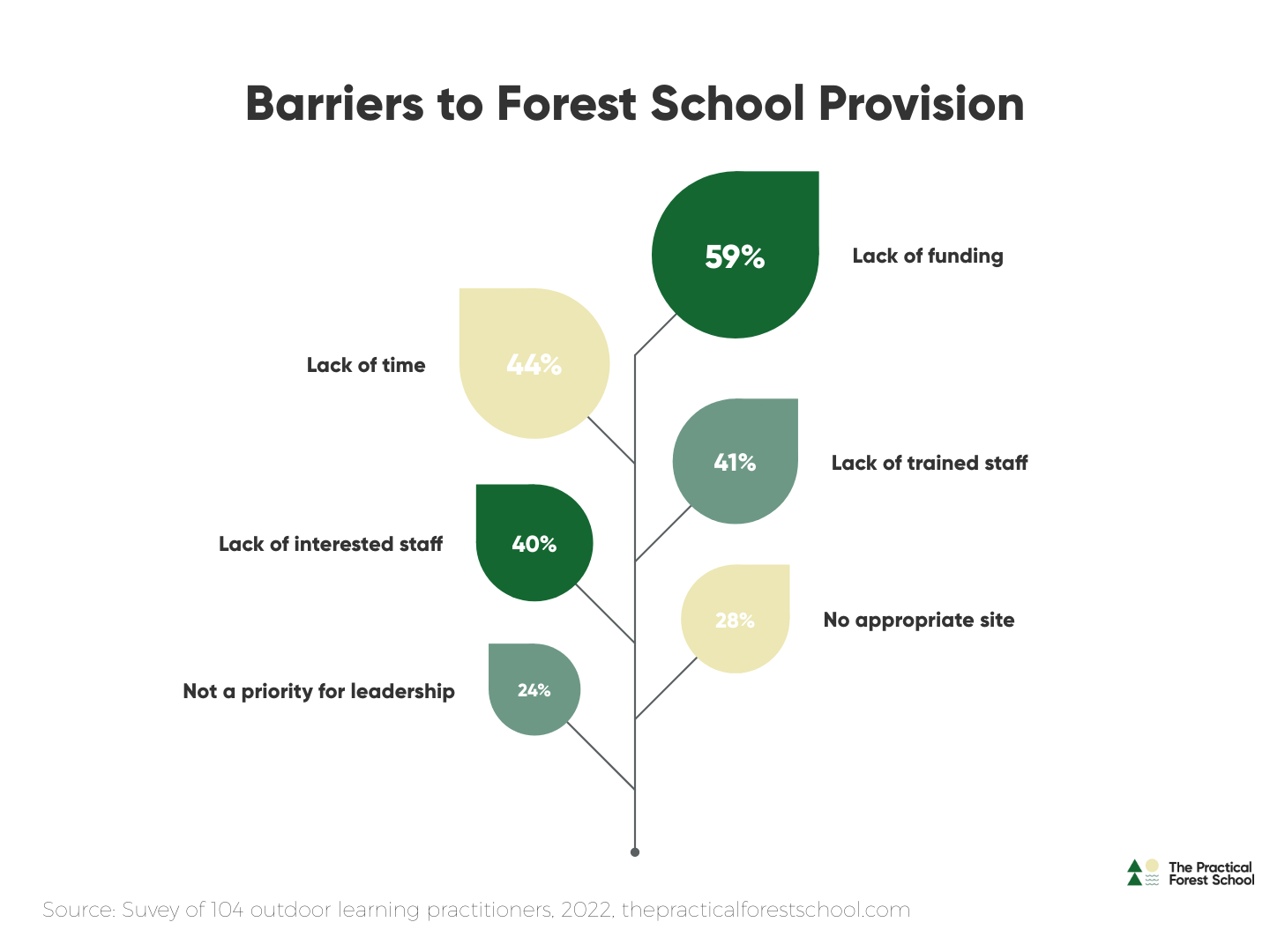
The main barrier to forest school provision is lack of funding. Given that forest school sessions don’t typically need much in the way of materials, it’s interesting that money is the problem. Whether that’s the funds to buy a Kelly kettle or to pay staff to deliver the sessions, lack of willingness to find the money is always going to be a problem.
Lack of funding was the most frequently reported barrier in the Sylva Foundation survey too. It’s sad that nothing has moved on in that respect since 2019.
The next largest issue was having the time. Given that 60% of respondents were salaried staff members at a school or preschool, there’s a time pressure on being able to deliver curriculum teaching. And right now, providing covid catch up lessons.
Over 40% of respondents felt that lack of trained staff was holding them back from being able to provide the forest school provision that they wanted. Interestingly, 40% reported a lack of staff being interested in forest school.
Not having a suitable location was identified as a barrier for 28% of people. And sadly, nearly a quarter of forest school professionals said it was not a priority for their leadership teams.
The Sylva Foundation’s report concluded that lack of available staff (about 35% reported this) and a lack of appropriate site (about 27% reported this) were the barriers for school educators back in 2019.
How practitioners feel about Forest School
We asked respondents to rate the following statements on a ‘strongly agree’ to ‘strongly disagree’ Likert scale, so there’s likely to be some individual interpretation in the results.
Outdoor learning has a positive benefit for emotional well-being
Unsurprisingly, 99% of respondents strongly agreed or agreed with this statement! The remaining 1% was neutral, and nobody disagreed.
A similar question was on the Sylva Foundation study, and again many practitioners scored it highly. I think our results showed a slightly higher bias, perhaps due to the increased focus on mental health in children since the start of the pandemic, or because our survey population was smaller.
Outdoor learning increases academic achievement
84% of participants strongly agreed or agreed with the idea that outdoor learning increases academic achievement. Only 1 person disagreed.
Respondents to the Sylva Foundation study reported about the same – showing that the views of the community haven’t changed much in the past few years.
Outdoor learning helps children develop social skills
The results were conclusive for this statement too: 99% of respondents strongly agreed or agreed that outdoor learning helps children develop their social skills.
Again, this is similar to the results of the Sylva Foundation study, which asked a similar quest and had a similar response.
So far, so predictable. Honestly, this is what we expected to see. From our relationships and conversations with other forest school practitioners, this is pretty much standard! If you didn’t support the idea of outdoor learning and forest school principals, you probably wouldn’t be in the role.
Outdoor learning is strongly supported by our leadership team
Here is where the numbers start to get more interesting. We were expecting to see that outdoor learning is not strongly supported by leadership teams in schools, nurseries and other settings, because again, that’s what we hear and see on the ground.
The response was pretty split. 69% of respondents agreed or strongly agreed that they had the support, with nearly 1 in 5 staying neutral on the subject.
We have adequate funding for outdoor learning
People feel strongly that there is not adequate funding for forest school sessions. Only 10% strongly agreed that there was enough money to deliver the provision they wanted.
Over half responded that funding was not adequate, with a fifth of people expressing a neutral opinion.
The pandemic has increased people’s awareness of the value of outdoor learning
Locally, we seem to be seeing an uptick in awareness and demand for outdoor education provision and forest school settings as a result of the pandemic, and that does seem to (broadly) be the wider experience too.
However, only 35% of people agreed or strongly agreed that the pandemic had increased awareness of what outdoor learning has to offer. 31% disagreed, so the results were pretty split.
The pandemic has increased demand for outdoor sessions
There was more of a distinction in results for this question. Three quarters of people felt that the pandemic had increased demand for outdoor sessions.
This is interesting because if 75% of forest school practitioners are saying there is more demand, but there still isn’t the funding, how are we supposed to meet demand? Pull more hours out of the day? Magic up some kit and waterproofs for the kids who arrive without anything?
It’s a tricky balance to be able to offer more while not having the support system (and cash) in place to provide that.
I have noticed an increase in demand for forest school provision in the past 12 months
61% of people reported an increased demand for forest school provision over the last year, with a quarter of respondents being neutral on the topic. Only 8% disagreed.
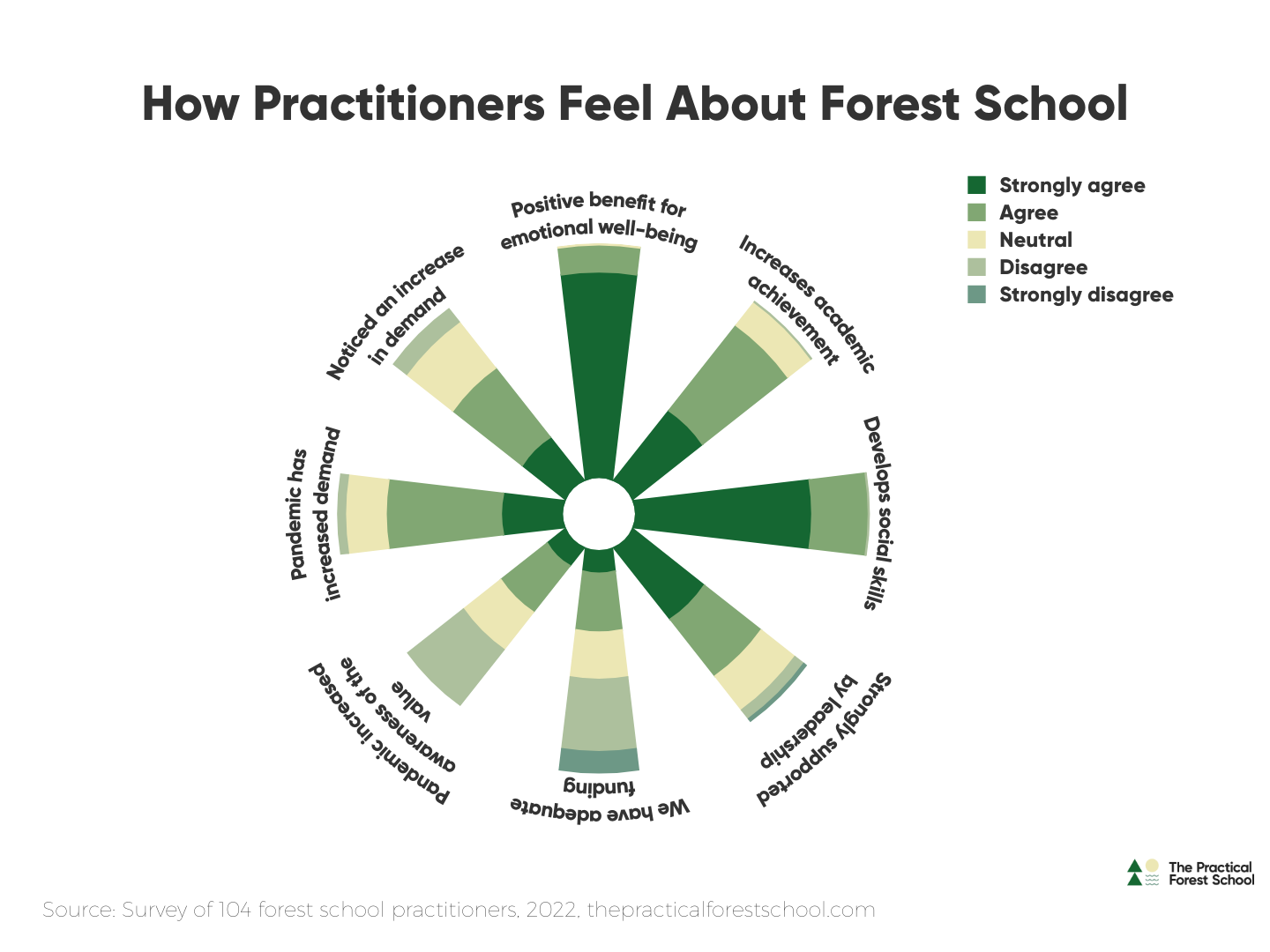
Top challenges for forest school provision
The survey offered respondents the opportunity to provide narrative comments on their biggest challenges in delivering forest school or outdoor learning sessions. The responses were varied and focused on the topics we saw highlighted in the previous section: resources, locations, funding and support from colleagues and leaders in their setting.
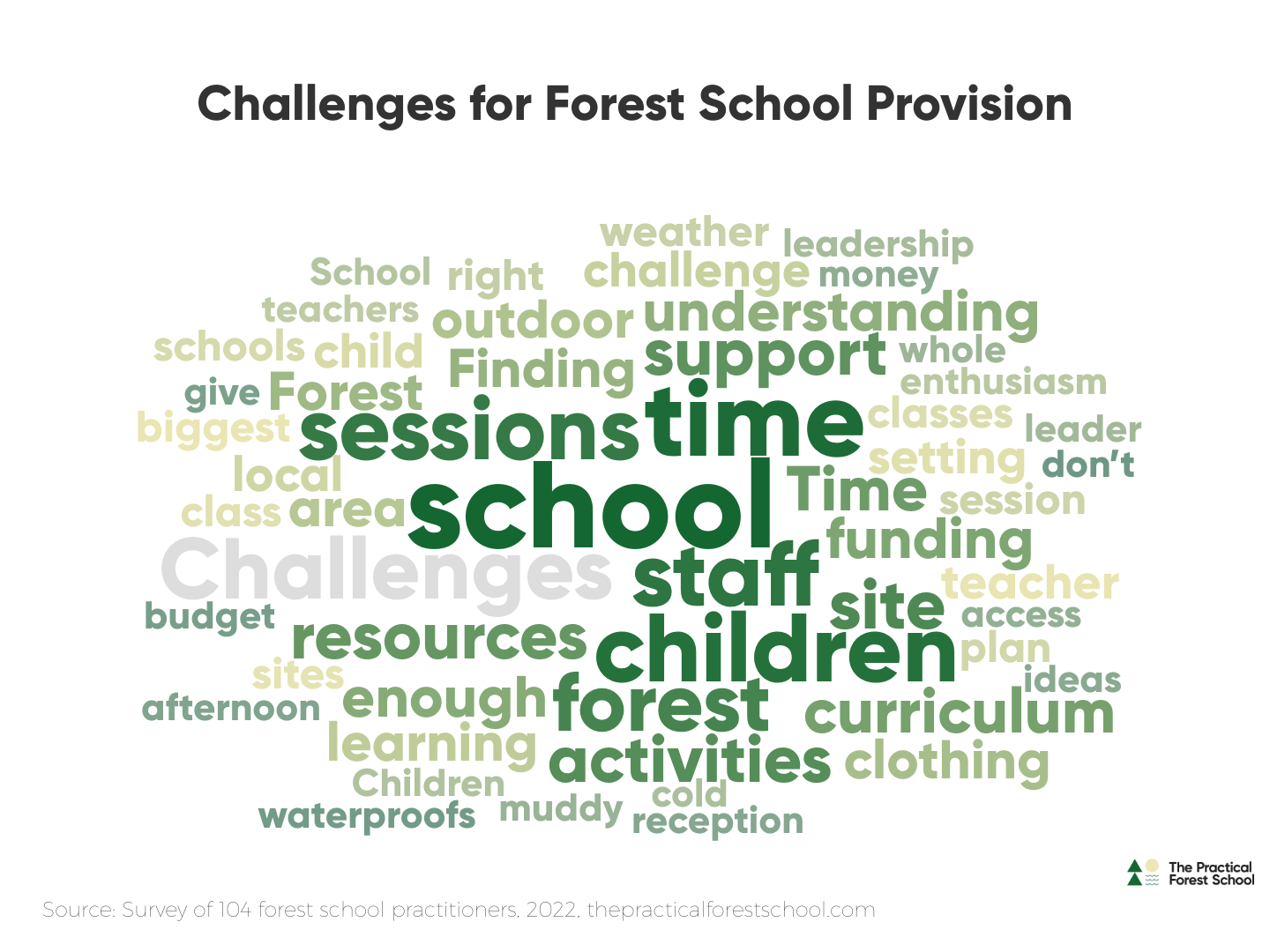
The verbatim comments were really interesting. Here’s a selection.
- Not having our own space. Having to clear rubbish/drug use/dog mess.
- Parents not wanting their child to do or getting cold dirty etc
- Time, ability to be allowed to plan own session instead of following curriculum. More awareness of how this works, tried to get the ethos across to SLT [senior leadership team] but they don’t see it. Fair weather lessons done by SLT even though [they] had a qualified forest school leader.
- Staff support. I now work freelance but have recently left an early years setting. I ran the whole outdoor area alone because no one else had any interest in it. I requested staff have forest school intro training but it never happened. It got too much for me in the end, hence why I started out on my own.
- Having enough time and being able to be purely child led rather than outdoor learning.
- Working with staff who do not like being outside. Expectations of SLT. No time to plan and look after the site along with cleaning clothing and tools etc.
Also staff not understanding that there is no electricity outside and I don’t have a laptop constantly in front of me. - The main challenge has been overuse of relatively small sites which has made impacted on the environment, trampled grass, very muddy areas, less vegetation allowed to grow up. We have not had funding for school provided outdoor clothing, so been dependent on children coming in well/suitably dressed, which is not always the case (although we do have some spares). As a teacher I have not really counted my hours for setting up etc… budgets for equipment is limited and I am not very good at claiming back petty cash spent for FS, and I have found TA colleagues who run sessions are given very little paid time for preparation.
- School leadership team seeing it as a tick box, trying to send too big a group up which doesn’t allow for successful sessions and can turn into crowd management. Not understanding the ethos behind fs, just trying to prove as many children as possible are doing it, when the sessions aren’t as good as they can be because of this.
- Logistics and toileting
- Outdoor Learning is not yet embedded in the curriculum and, as such, many leaders do not take time to build outdoor learning activities into the curriculum. It continues to be seen as a standalone subject but we are working hard to develop understanding and enthusiasm!
- No time included in day for setting up and clearing away. I start in my own time and finish in my own time. Preparation, planning, evaluation etc all done in my own time. No time to wash waterproofs. Any maintenance is done in my own time.
No storage facilities for easy access for children to independently get resources out themselves and to put back at the end of the day.
No funding and struggling to get any resources - Being a class teacher as well as the forest school teacher I find lack of time the biggest challenge. Planning and Preparing resources for forest school is time consuming when you have all the other responsibilities of assessment, data, reporting etc that comes with being a class teacher. Just wish I had more time!
- Forest school is becoming tokenistic rather than being seen as a a valid way to deliver the curriculum
What help practitioners need
You don’t morph into a forest school leader overnight. The Level 3 training is a significant time commitment, and on top of that there is professional development, ongoing learning and informally training your colleagues so they can help during sessions – or at least be supportive of the general idea.
And who has enough hours in the day for all of that?
We asked: “What sort of information or instruction would you find useful?”
- 48% said knots and ropework
- 46% said easy activities for Key Stage 1
- 41% said activities for older children
- 40% said easy activities for Key Stage 2
- 34% said easy activities for early years
- 28% said how to set up a forest school site
- 21% said health and safety outdoors
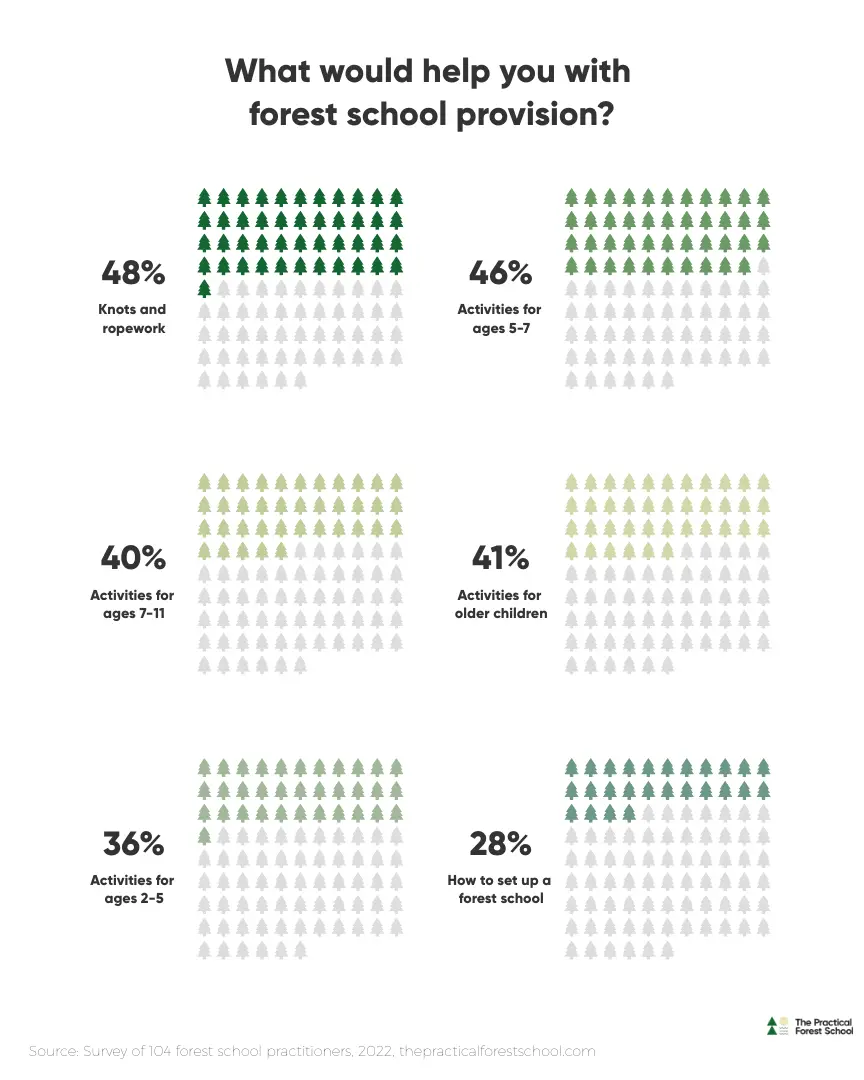
Other comments included:
“Training for leadership staff in the relevance of outdoor learning. The pandemic in my area has meant staff having to do more with less and outdoor learning and forest school are low priorities. They don’t have the funds to pay freelancers, so forest school is mostly happening with school staff, often untrained.”
“Face-to-face support is really beneficial as the role can be quite solitary.”
“Activities for children with a social emotional mental health diagnosis.”
“Shelter building, using fire. I find the 7-11 age group most difficult as some children are really interested and invested, some have more experience and are engaged, and some children are in a ‘too cool for school’ phase or a place where they might engage in more hazardous behaviour with their peers.”
“Woodworking skills.”
“CPD for experienced leaders.”
There is a lot of information available on line (and some activities suitable for different age groups on this blog) but I agree that the face-to-face support of a local group is invaluable – and a great place to get ideas.
Where do Forest School practitioners work?
Forest school provision seems most prevalent in primary schools.
- 84% of respondents work in a primary setting
- 41% work in preschools
- 29% work in nurseries
- 29% work in secondary schools
Only 45% of respondents work with one age group, and of that segment, 87% work only with primary. You could conclude from those numbers that primary schools are more invested in forest school provision, and we have work to do to expand delivery into secondary schools and early years.
These numbers reflect a similar split to the Sylva Foundation study, which showed that 50% of respondents were from primary schools.
Who took the survey?
Most of the people who took the survey identified as salaried educators employed as a staff member in a school or preschool (60%).
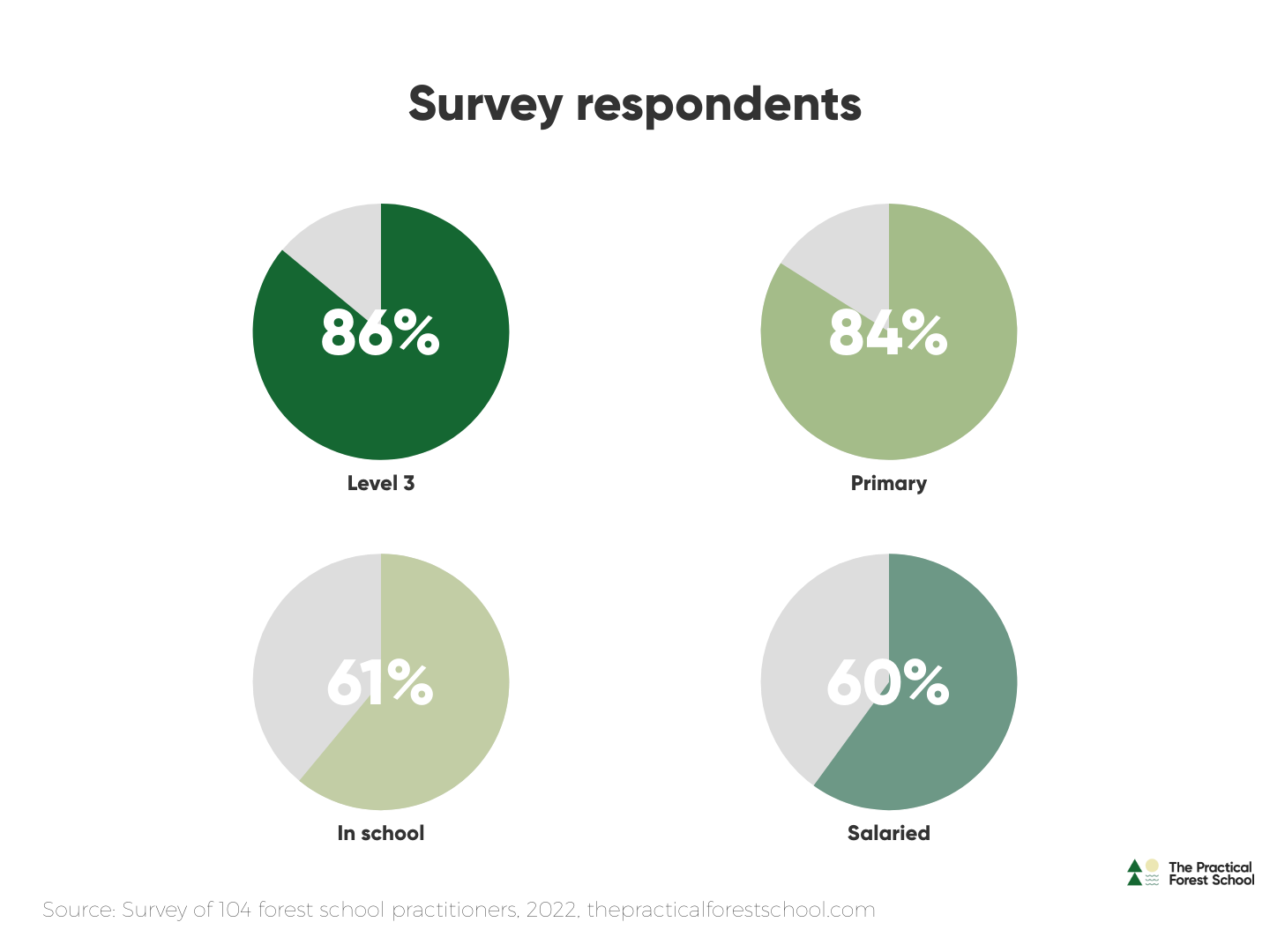
45% identified as a freelance or independent practitioner, with 4% operating in a volunteer position. As you can see, those numbers don’t add up to 100% and people were able to select multiple options.
Several respondents stated that they worked in multiple settings, for example as a freelance educator and also in a youth volunteer role, or in more than one school setting.
What do they do all day? Here’s what we found out.
- 61% deliver sessions in school grounds
- 48% deliver session outside of school grounds
- 35% offer other types of forest school sessions like holiday clubs or parent and toddler groups
- 39% provide curriculum-based outdoor learning
- 17% provide non-curriculum based outdoor learning such as youth group activities
- 10% operate day events like visiting a school as a forest school practitioner or children attending off-site sessions for the day
Certifications and qualifications
97% of survey respondents had either Level 1, Level 2, Level 3, or Level 4 Forest School certification or were working towards it.
The remaining 3% of respondents included people who had other certifications such as outdoor learning practitioner, forest bathing, horticulture or forestry.
Survey method
The survey questions were inspired by the topics the Sylva Foundation asked in 2019. Our survey was promoted to our mailing list and on social media, so participants self-selected to take part. The was open between 16 November 2021 and 16 January 2022.
Participants in that group were located around the world and we did not ask for geographic location as part of the survey, so our results do not make it possible to identify whether these findings differ per country. However, as the number of responses was small (104), it’s likely we would not have got enough participants from various locations to justify that anyway.
Most questions were optional, so response numbers differ for each question.
The other important point to note is that the survey was open to anyone involved in outdoor work with young people. While the focus was on forest school delivery, we did not prevent other outdoor learning professionals such as Teaching Assistants within schools, youth group leaders and so on, from taking part.

About the author: Elizabeth Borley
Elizabeth is our forest school administrator, responsible for running the website and managing bookings for afterschool clubs. She is a member of the Forest Childcare Association and loves walking in the woods and places with a view. As a parent, she understands the value of children spending time outdoors.